The Influence of the Selection at the Amino Acid Level on Synonymous Codon Usage from the Viewpoint of Alternative Genetic Codes
Abstract
1. Introduction
2. Results
2.1. General Performance of Genetic Codes in Terms of the Selection Strength at the Amino Acid Level on the Codon Usage
2.2. The Importance of Individual Assignments in Alternative Genetic Codes in the Selection Strength on Codon Usage
2.3. The Influence of Mutational Pressure on the Selection Strength on Codon Usage
2.4. The Comparison of Calculated Deviations in the Codon Usage with That Observed in Protein-Coding Genes
3. Discussion
4. Materials and Methods
Supplementary Materials
Author Contributions
Funding
Institutional Review Board Statement
Informed Consent Statement
Data Availability Statement
Acknowledgments
Conflicts of Interest
References
- Sharp, P.M.; Li, W.H. An evolutionary perspective on synonymous codon usage in unicellular organisms. J. Mol. Evol. 1986, 24, 28–38. [Google Scholar] [CrossRef] [PubMed]
- Plotkin, J.B.; Kudla, G. Synonymous but not the same: The causes and consequences of codon bias. Nat. Rev. Genet. 2011, 12, 32–42. [Google Scholar] [CrossRef]
- Iriarte, A.; Lamolle, G.; Musto, H. Codon usage bias: An endless tale. J. Mol. Evol. 2021, 89, 589–593. [Google Scholar] [CrossRef] [PubMed]
- Parvathy, S.T.; Udayasuriyan, V.; Bhadana, V. Codon usage bias. Mol. Biol. Rep. 2022, 49, 539–565. [Google Scholar] [CrossRef] [PubMed]
- Knight, R.D.; Freeland, S.J.; Landweber, L.F. A simple model based on mutation and selection explains trends in codon and amino-acid usage and GC composition within and across genomes. Genome Biol. 2001, 2, RESEARCH0010. [Google Scholar] [CrossRef] [PubMed]
- Chen, S.L.; Lee, W.; Hottes, A.K.; Shapiro, L.; McAdams, H.H. Codon usage between genomes is constrained by genome-wide mutational processes. Proc. Natl. Acad. Sci. USA 2004, 101, 3480–3485. [Google Scholar] [CrossRef] [PubMed]
- Li, J.; Zhou, J.; Wu, Y.; Yang, S.; Tian, D. GC-content of synonymous codons profoundly influences amino acid usage. G3-Genes Genomes Genet. (Bethesda Md.) 2015, 5, 2027–2036. [Google Scholar] [CrossRef]
- Fedorov, A.; Saxonov, S.; Gilbert, W. Regularities of context-dependent codon bias in eukaryotic genes. Nucleic Acids Res. 2002, 30, 1192–1197. [Google Scholar] [CrossRef]
- Scaiewicz, V.; Sabbía, V.; Piovani, R.; Musto, H. CpG islands are the second main factor shaping codon usage in human genes. Biochem. Biophys. Res. Commun. 2006, 343, 1257–1261. [Google Scholar] [CrossRef]
- Lafay, B.; Lloyd, A.T.; McLean, M.J.; Devine, K.M.; Sharp, P.M.; Wolfe, K.H. Proteome composition and codon usage in spirochaetes: Species-specific and DNA strand-specific mutational biases. Nucleic Acids Res. 1999, 27, 1642–1649. [Google Scholar] [CrossRef]
- Mackiewicz, P.; Gierlik, A.; Kowalczuk, M.; Dudek, M.R.; Cebrat, S. How does replication-associated mutational pressure influence amino acid composition of proteins? Genome Res. 1999, 9, 409–416. [Google Scholar] [CrossRef]
- Mackiewicz, P.; Gierlik, A.; Kowalczuk, M.; Szczepanik, D.; Dudek, M.R.; Cebrat, S. Mechanisms generating long-range correlation in nucleotide composition of the Borrelia burgdorferi genome. Phys. A 1999, 273, 103–115. [Google Scholar] [CrossRef]
- Rocha, E.P.; Danchin, A.; Viari, A. Universal replication biases in bacteria. Mol. Microbiol. 1999, 32, 11–16. [Google Scholar] [CrossRef] [PubMed]
- Qu, H.; Wu, H.; Zhang, T.; Zhang, Z.; Hu, S.; Yu, J. Nucleotide compositional asymmetry between the leading and lagging strands of eubacterial genomes. Res. Microbiol. 2010, 161, 838–846. [Google Scholar] [CrossRef] [PubMed]
- Bennetzen, J.L.; Hall, B.D. Codon selection in yeast. J. Biol. Chem. 1982, 257, 3026–3031. [Google Scholar] [CrossRef]
- Ikemura, T. Codon usage and tRNA content in unicellular and multicellular organisms. Mol. Biol. Evol. 1985, 2, 13–34. [Google Scholar] [CrossRef]
- Duret, L.; Mouchiroud, D. Expression pattern and, surprisingly, gene length shape codon usage in Caenorhabditis, Drosophila, and Arabidopsis. Proc. Natl. Acad. Sci. USA 1999, 96, 4482–4487. [Google Scholar] [CrossRef]
- Goetz, R.M.; Fuglsang, A. Correlation of codon bias measures with mRNA levels: Analysis of transcriptome data from Escherichia coli. Biochem. Biophys. Res. Commun. 2005, 327, 4–7. [Google Scholar] [CrossRef]
- Kanaya, S.; Yamada, Y.; Kudo, Y.; Ikemura, T. Studies of codon usage and tRNA genes of 18 unicellular organisms and quantification of Bacillus subtilis tRNAs: Gene expression level and species-specific diversity of codon usage based on multivariate analysis. Gene 1999, 238, 143–155. [Google Scholar] [CrossRef]
- Rocha, E.P.C. Codon usage bias from tRNA’s point of view: Redundancy, specialization, and efficient decoding for translation optimization. Genome Res. 2004, 14, 2279–2286. [Google Scholar] [CrossRef]
- Cannarrozzi, G.; Schraudolph, N.N.; Faty, M.; von Rohr, P.; Friberg, M.T.; Roth, A.C.; Gonnet, P.; Gonnet, G.; Barral, Y. A role for codon order in translation dynamics. Cell 2010, 141, 355–367. [Google Scholar] [CrossRef]
- Supek, F.; Skunca, N.; Repar, J.; Vlahovicek, K.; Smuc, T. Translational selection is ubiquitous in prokaryotes. PLoS Genet. 2010, 6, e1001004. [Google Scholar] [CrossRef] [PubMed]
- Gu, W.; Zhou, T.; Wilke, C.O. A universal trend of reduced mRNA stability near the translation-initiation site in prokaryotes and eukaryotes. PLoS Comput. Biol. 2010, 6, e1000664. [Google Scholar] [CrossRef]
- Oresic, M.; Shalloway, D. Specific correlations between relative synonymous codon usage and protein secondary structure. J. Mol. Biol. 1998, 281, 31–48. [Google Scholar] [CrossRef] [PubMed]
- Quax, T.E.F.; Claassens, N.J.; Söll, D.; van der Oost, J. Codon bias as a means to fine-tune gene expression. Mol. Cell 2015, 59, 149–161. [Google Scholar] [CrossRef] [PubMed]
- Liu, Y. A code within the genetic code: Codon usage regulates co-translational protein folding. Cell Commun. Signal. 2020, 18, 145. [Google Scholar] [CrossRef]
- Tuller, T.; Carmi, A.; Vestsigian, K.; Navon, S.; Dorfan, Y.; Zaborske, J.; Pan, T.; Dahan, O.; Furman, I.; Pilpel, Y. An evolutionarily conserved mechanism for controlling the efficiency of protein translation. Cell 2010, 141, 344–354. [Google Scholar] [CrossRef]
- Kudla, G.; Lipinski, L.; Caffin, F.; Helwak, A.; Zylicz, M. High guanine and cytosine content increases mRNA levels in mammalian cells. PLoS Biol. 2006, 4, e180. [Google Scholar] [CrossRef]
- Zhou, Z.; Dang, Y.; Zhou, M.; Li, L.; Yu, C.H.; Fu, J.; Chen, S.; Liu, Y. Codon usage is an important determinant of gene expression levels largely through its effects on transcription. Proc. Natl. Acad. Sci. USA 2016, 113, E6117–E6125. [Google Scholar] [CrossRef] [PubMed]
- Zhou, Z.; Dang, Y.; Zhou, M.; Yuan, H.; Liu, Y. Codon usage biases co-evolve with transcription termination machinery to suppress premature cleavage and polyadenylation. eLife 2018, 7, e33569. [Google Scholar] [CrossRef]
- Presnyak, V.; Alhusaini, N.; Chen, Y.H.; Martin, S.; Morris, N.; Kline, N.; Olson, S.; Weinberg, D.; Baker, K.E.; Graveley, B.R.; et al. Codon optimality is a major determinant of mRNA stability. Cell 2015, 160, 1111–1124. [Google Scholar] [CrossRef] [PubMed]
- Morton, B.R. Selection at the amino acid level can influence synonymous codon usage: Implications for the study of codon adaptation in plastid genes. Genetics 2001, 159, 347–358. [Google Scholar] [CrossRef] [PubMed]
- Błażej, P.; Mackiewicz, D.; Wnetrzak, M.; Mackiewicz, P. The impact of selection at the amino acid level on the usage of synonymous codons. G3-Genes Genomes Genet. (Bethesda Md.) 2017, 7, 967–981. [Google Scholar] [CrossRef] [PubMed]
- Osawa, S.; Ohama, T.; Jukes, T.H.; Watanabe, K. Evolution of the mitochondrial genetic code. I. Origin of AGR serine and stop codons in metazoan mitochondria. J. Mol. Evol. 1989, 29, 202–207. [Google Scholar] [CrossRef]
- Boore, J.L.; Brown, W.M. Complete DNA sequence of the mitochondrial genome of the black chiton, Katharina tunicata. Genetics 1994, 138, 423–443. [Google Scholar] [CrossRef]
- Clark-Walker, G.D.; Weiller, G.F. The structure of the small mitochondrial DNA of Kluyveromyces thermotolerans is likely to reflect the ancestral gene order in fungi. J. Mol. Evol. 1994, 38, 593–601. [Google Scholar] [CrossRef]
- Knight, R.D.; Landweber, L.F.; Yarus, M. How mitochondria redefine the code. J. Mol. Evol. 2001, 53, 299–313. [Google Scholar] [CrossRef]
- Yokobori, S.; Watanabe, Y.; Oshima, T. Mitochondrial genome of Ciona savignyi (Urochordata, Ascidiacea, Enterogona): Comparison of gene arrangement and tRNA genes with Halocynthia roretzi mitochondrial genome. J. Mol. Evol. 2003, 57, 574–587. [Google Scholar] [CrossRef]
- Abascal, F.; Posada, D.; Zardoya, R. The evolution of the mitochondrial genetic code in arthropods revisited. Mitochondrial DNA 2012, 23, 84–91. [Google Scholar] [CrossRef]
- Lang-Unnasch, N.; Aiello, D.P. Sequence evidence for an altered genetic code in the Neospora caninum plastid. Int. J. Parasitol. 1999, 29, 1557–1562. [Google Scholar] [CrossRef]
- Janouskovec, J.; Sobotka, R.; Lai, D.H.; Flegontov, P.; Konik, P.; Komenda, J.; Ali, S.; Prasil, O.; Pain, A.; Obornik, M.; et al. Split photosystem protein, linear-mapping topology, and growth of structural complexity in the plastid genome of Chromera velia. Mol. Biol. Evol. 2013, 30, 2447–2462. [Google Scholar] [CrossRef] [PubMed]
- Del Cortona, A.; Leliaert, F.; Bogaert, K.A.; Turmel, M.; Boedeker, C.; Janouskovec, J.; Lopez-Bautista, J.M.; Verbruggen, H.; Vandepoele, K.; De Clerck, O. The plastid genome in Cladophorales green algae is encoded by hairpin chromosomes. Curr. Biol. 2017, 27, 3771–3782.e6. [Google Scholar] [CrossRef]
- Lim, P.O.; Sears, B.B. Evolutionary relationships of a plant-pathogenic mycoplasmalike organism and Acholeplasma laidlawii deduced from two ribosomal protein gene sequences. J. Bacteriol. 1992, 174, 2606–2611. [Google Scholar] [CrossRef]
- Bove, J.M. Molecular features of mollicutes. Clin. Infect. Dis. 1993, 17 (Suppl. 1), S10–S31. [Google Scholar] [CrossRef] [PubMed]
- McCutcheon, J.P.; McDonald, B.R.; Moran, N.A. Origin of an alternative genetic code in the extremely small and GC-rich genome of a bacterial symbiont. PLoS Genet. 2009, 5, e1000565. [Google Scholar] [CrossRef] [PubMed]
- Campbell, J.H.; O’Donoghue, P.; Campbell, A.G.; Schwientek, P.; Sczyrba, A.; Woyke, T.; Soll, D.; Podar, M. UGA is an additional glycine codon in uncultured SR1 bacteria from the human microbiota. Proc. Natl. Acad. Sci. USA 2013, 110, 5540–5545. [Google Scholar] [CrossRef]
- Schneider, S.U.; Leible, M.B.; Yang, X.P. Strong homology between the small subunit of ribulose-1,5-bisphosphate carboxylase/oxygenase of two species of Acetabularia and the occurrence of unusual codon usage. Mol. Gen. Genet. 1989, 218, 445–452. [Google Scholar] [CrossRef]
- Santos, M.A.S.; Keith, G.; Tuite, M.F. Non-standard translational events in Candida albicans mediated by an unusual seryl-tRNA with a 5’-CAG-3’ (leucine) anticodon. EMBO J. 1993, 12, 607–616. [Google Scholar] [CrossRef]
- Hoffman, D.C.; Anderson, R.C.; Dubois, M.L.; Prescott, D.M. Macronuclear gene-sized molecules of hypotrichs. Nucleic Acids Res. 1995, 23, 1279–1283. [Google Scholar] [CrossRef]
- Panek, T.; Zihala, D.; Sokol, M.; Derelle, R.; Klimes, V.; Hradilova, M.; Zadrobilkova, E.; Susko, E.; Roger, A.J.; Cepicka, I.; et al. Nuclear genetic codes with a different meaning of the UAG and the UAA codon. BMC Biol. 2017, 15, 8. [Google Scholar] [CrossRef]
- Sanchez-Silva, R.; Villalobo, E.; Morin, L.; Torres, A. A new noncanonical nuclear genetic code: Translation of UAA into glutamate. Curr. Biol. 2003, 13, 442–447. [Google Scholar] [CrossRef] [PubMed]
- Heaphy, S.M.; Mariotti, M.; Gladyshev, V.N.; Atkins, J.F.; Baranov, P.V. Novel ciliate genetic code variants including the reassignment of all three stop codons to sense codons in Condylostoma magnum. Mol. Biol. Evol. 2016, 33, 2885–2889. [Google Scholar] [CrossRef] [PubMed]
- Muhlhausen, S.; Findeisen, P.; Plessmann, U.; Urlaub, H.; Kollmar, M. A novel nuclear genetic code alteration in yeasts and the evolution of codon reassignment in eukaryotes. Genome Res. 2016, 26, 945–955. [Google Scholar] [CrossRef] [PubMed]
- Sengupta, S.; Higgs, P.G. A unified model of codon reassignment in alternative genetic codes. Genetics 2005, 170, 831–840. [Google Scholar] [CrossRef] [PubMed]
- Sengupta, S.; Yang, X.; Higgs, P.G. The mechanisms of codon reassignments in mitochondrial genetic codes. J. Mol. Evol. 2007, 64, 662–688. [Google Scholar] [CrossRef]
- Błażej, P.; Wnetrzak, M.; Mackiewicz, D.; Gagat, P.; Mackiewicz, P. Many alternative and theoretical genetic codes are more robust to amino acid replacements than the standard genetic code. J. Theor. Biol. 2019, 464, 21–32. [Google Scholar] [CrossRef]
- Błażej, P.; Wnetrzak, M.; Mackiewicz, P. The importance of changes observed in the alternative genetic codes. In Proceedings of the 11th International Joint Conference on Biomedical Engineering Systems and Technologies—Volume 4: BIOINFORMATICS, Funchal, Madeira, Portugal, 19–21 January 2018; pp. 154–159. [Google Scholar] [CrossRef]
- Novozhilov, A.S.; Wolf, Y.I.; Koonin, E.V. Evolution of the genetic code: Partial optimization of a random code for robustness to translation error in a rugged fitness landscape. Biol. Direct 2007, 2, 24. [Google Scholar] [CrossRef]
- Massey, S.E. A neutral origin for error minimization in the genetic code. J. Mol. Evol. 2008, 67, 510–516. [Google Scholar] [CrossRef]
- Santos, M.A.S.; Gomes, A.C.; Santos, M.C.; Carreto, L.C.; Moura, G.R. The genetic code of the fungal CTG clade. C. R. Biol. 2011, 334, 607–611. [Google Scholar] [CrossRef]
- Błażej, P.; Wnetrzak, M.; Mackiewicz, P. The role of crossover operator in evolutionary-based approach to the problem of genetic code optimization. BioSystems 2016, 150, 61–72. [Google Scholar] [CrossRef]
- Santos, J.; Monteagudo, A. Inclusion of the fitness sharing technique in an evolutionary algorithm to analyze the fitness landscape of the genetic code adaptability. BMC Bioinform. 2017, 18, 195. [Google Scholar] [CrossRef] [PubMed]
- Wnetrzak, M.; Błażej, P.; Mackiewicz, D.; Mackiewicz, P. The optimality of the standard genetic code assessed by an eight-objective evolutionary algorithm. BMC Evol. Biol. 2018, 18, 192. [Google Scholar] [CrossRef] [PubMed]
- Błażej, P.; Wnetrzak, M.; Mackiewicz, D.; Mackiewicz, P. Optimization of the standard genetic code according to three codon positions using an evolutionary algorithm. PLoS ONE 2018, 13, e0201715. [Google Scholar] [CrossRef]
- Błażej, P.; Wnetrzak, M.; Mackiewicz, D.; Mackiewicz, P. The influence of different types of translational inaccuracies on the genetic code structure. BMC Bioinform. 2019, 20, 114. [Google Scholar] [CrossRef]
- Wnetrzak, M.; Błażej, P.; Mackiewicz, P. Optimization of the standard genetic code in terms of two mutation types: Point mutations and frameshifts. BioSystems 2019, 181, 44–50. [Google Scholar] [CrossRef]
- Grantham, R. Amino acid difference formula to help explain protein evolution. Science 1974, 185, 862–864. [Google Scholar] [CrossRef]
- Swart, E.C.; Serra, V.; Petroni, G.; Nowacki, M. Genetic codes with no dedicated stop codon: Context-dependent translation termination. Cell 2016, 166, 691–702. [Google Scholar] [CrossRef]
- Zahonova, K.; Kostygov, A.Y.; Sevcikova, T.; Yurchenko, V.; Elias, M. An unprecedented non-canonical nuclear genetic code with all three termination codons reassigned as sense codons. Curr. Biol. 2016, 26, 2364–2369. [Google Scholar] [CrossRef]
- Li, Y.; Kocot, K.M.; Tassia, M.G.; Cannon, J.T.; Bernt, M.; Halanych, K.M. Mitogenomics reveals a novel genetic code in Hemichordata. Genome Biol. Evol. 2019, 11, 29–40. [Google Scholar] [CrossRef]
- Moran, N.A. Microbial minimalism: Genome reduction in bacterial pathogens. Cell 2002, 108, 583–586. [Google Scholar] [CrossRef]
- Pallen, M.J.; Wren, B.W. Bacterial pathogenomics. Nature 2007, 449, 835–842. [Google Scholar] [CrossRef] [PubMed]
- Hershberg, R.; Petrov, D.A. Evidence that mutation is universally biased towards AT in bacteria. PLoS Genet. 2010, 6, e1001115. [Google Scholar] [CrossRef] [PubMed]
- McCutcheon, J.P.; Moran, N.A. Functional convergence in reduced genomes of bacterial symbionts spanning 200 My of evolution. Genome Biol. Evol. 2010, 2, 708–718. [Google Scholar] [CrossRef] [PubMed]
- Wernegreen, J.J. Endosymbiont evolution: Predictions from theory and surprises from genomes. Ann. N. Y. Acad. Sci. 2015, 1360, 16–35. [Google Scholar] [CrossRef] [PubMed]
- Videvall, E. Plasmodium parasites of birds have the most AT-rich genes of eukaryotes. Microb. Genom. 2018, 4, e000150. [Google Scholar] [CrossRef]
- George, E.E.; Husnik, F.; Tashyreva, D.; Prokopchuk, G.; Horák, A.; Kwong, W.K.; Lukeš, J.; Keeling, P.J. Highly reduced genomes of protist endosymbionts show evolutionary convergence. Curr. Biol. 2020, 30, 925–933.e3. [Google Scholar] [CrossRef]
- Smith, D.R. Updating our view of organelle genome nucleotide landscape. Front. Genet. 2012, 3, 175. [Google Scholar] [CrossRef]
- Formaggioni, A.; Luchetti, A.; Plazzi, F. Mitochondrial genomic landscape: A portrait of the mitochondrial genome 40 years after the first complete sequence. Life 2021, 11, 663. [Google Scholar] [CrossRef]
- Hildebrand, F.; Meyer, A.; Eyre-Walker, A. Evidence of selection upon genomic GC-content in bacteria. PLoS Genet. 2010, 6, e1001107. [Google Scholar] [CrossRef]
- Jitobaom, K.; Phakaratsakul, S.; Sirihongthong, T.; Chotewutmontri, S.; Suriyaphol, P.; Suptawiwat, O.; Auewarakul, P. Codon usage similarity between viral and some host genes suggests a codon-specific translational regulation. Heliyon 2020, 6, e03915. [Google Scholar] [CrossRef]
- Wang, Q.; Lyu, X.; Cheng, J.; Fu, Y.; Lin, Y.; Abdoulaye, A.H.; Jiang, D.; Xie, J. Codon usage provides insights into the adaptive evolution of mycoviruses in their associated fungi host. Int. J. Mol. Sci. 2022, 23, 7441. [Google Scholar] [CrossRef] [PubMed]
- Freire, C.C.d.M.; Palmisano, G.; Braconi, C.T.; Cugola, F.R.; Russo, F.B.; Beltrão-Braga, P.C.; Iamarino, A.; Lima Neto, D.F.d.; Sall, A.A.; Rosa-Fernandes, L.; et al. NS1 codon usage adaptation to humans in pandemic Zika virus. Mem. Do Inst. Oswaldo Cruz 2018, 113, e170385. [Google Scholar] [CrossRef] [PubMed]
- Tian, L.; Shen, X.; Murphy, R.W.; Shen, Y. The adaptation of codon usage of +ssRNA viruses to their hosts. Infect. Genet. Evol. J. Mol. Epidemiol. Evol. Genet. Infect. Dis. 2018, 63, 175–179. [Google Scholar] [CrossRef]
- Xia, X. How optimized is the translational machinery in Escherichia coli, Salmonella typhimurium and Saccharomyces cerevisiae? Genetics 1998, 149, 37–44. [Google Scholar] [CrossRef]
- Yang, Z. Estimating the pattern of nucleotide substitution. J. Mol. Evol. 1994, 39, 105–111. [Google Scholar] [CrossRef] [PubMed]
- De Jong, K.; Fogel, D.B.; Schwefel, H.P. A history of evolutionary computation. In Handbook of Evolutionary Computation; Baeck, T., Fogel, D., Michalewicz, Z., Eds.; IOP Publishing Ltd.: Bristol, UK; Oxford University Press: Oxford, UK, 1997; pp. 1–12. [Google Scholar] [CrossRef]
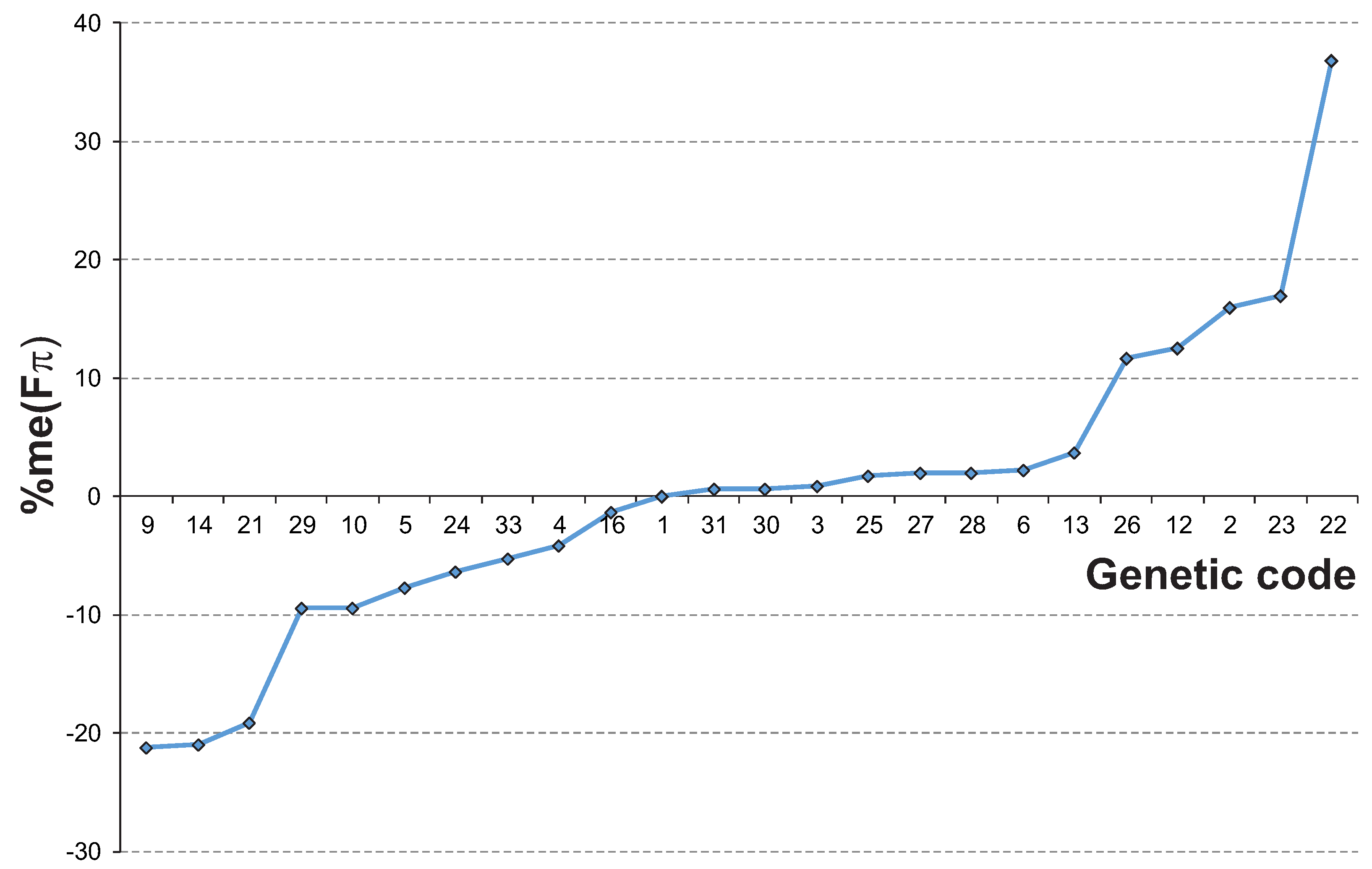
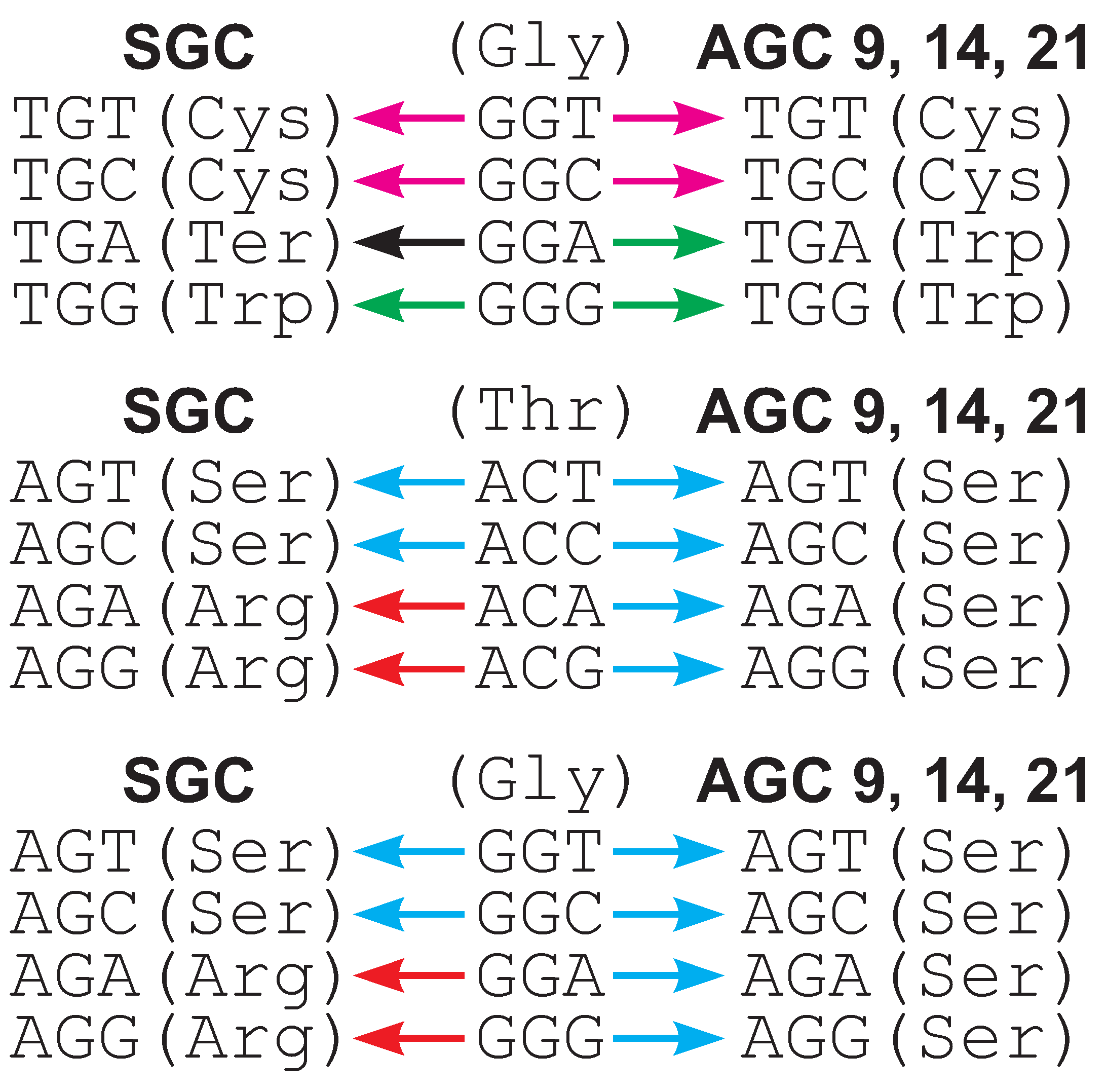
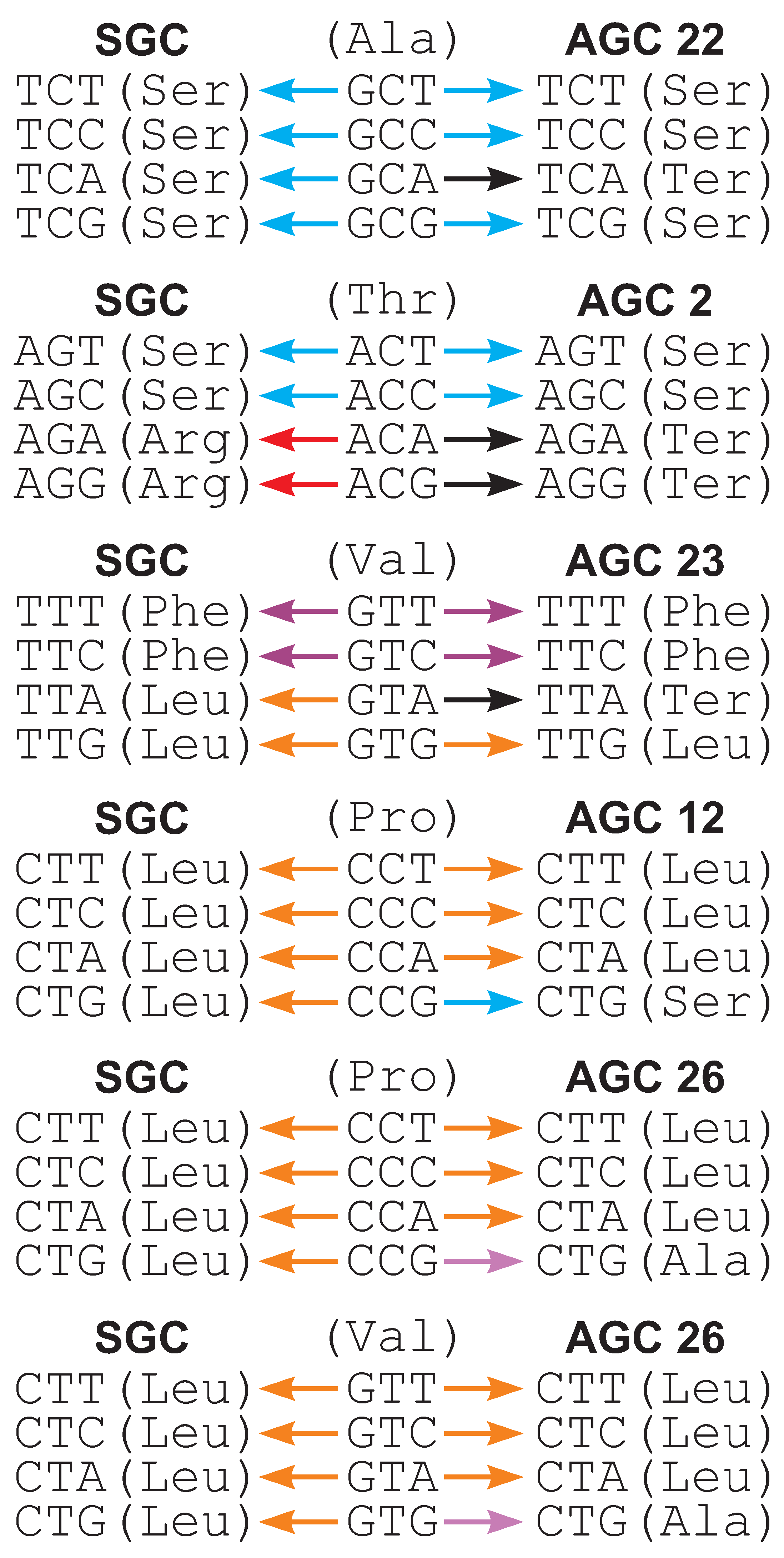

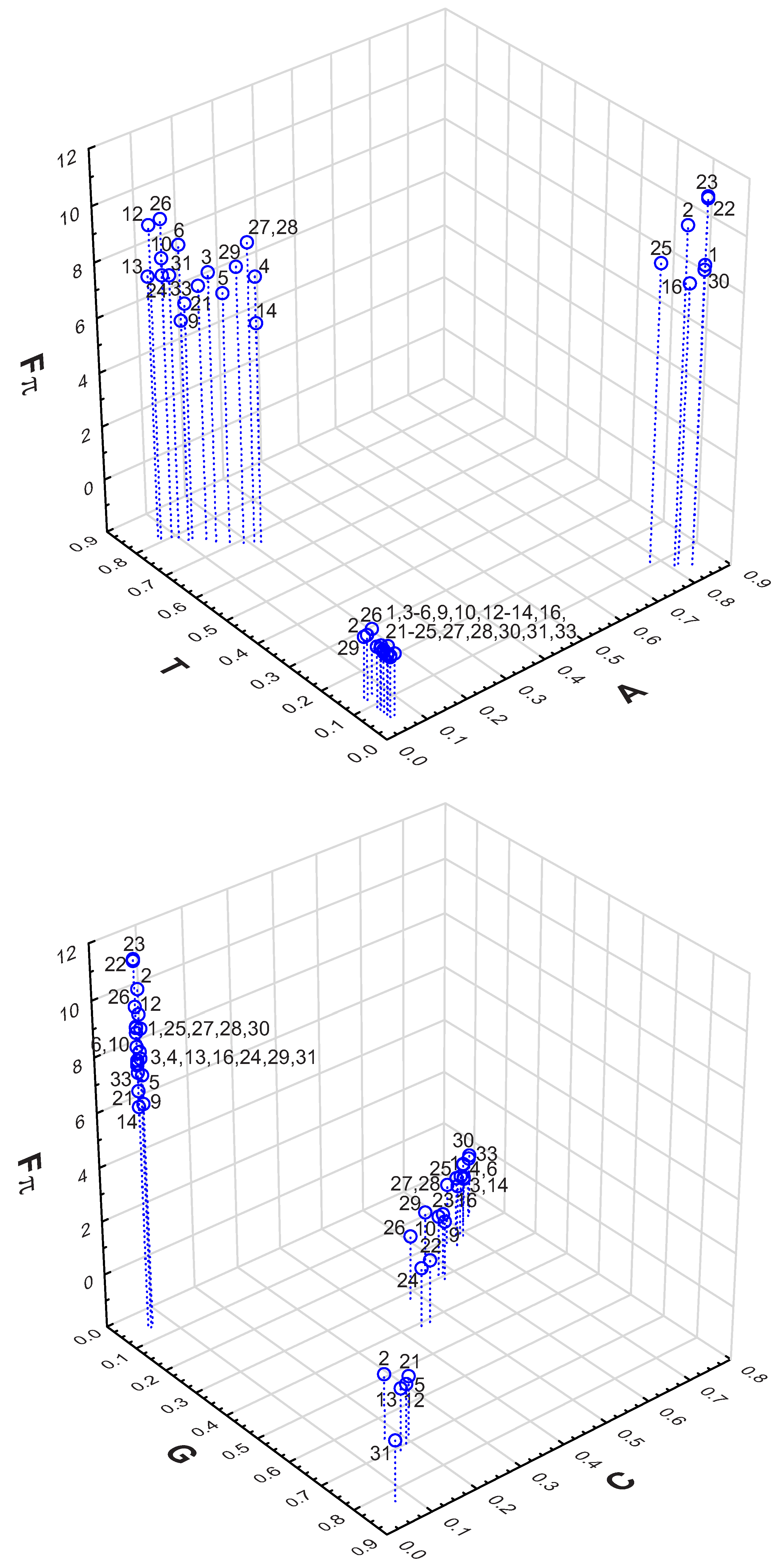

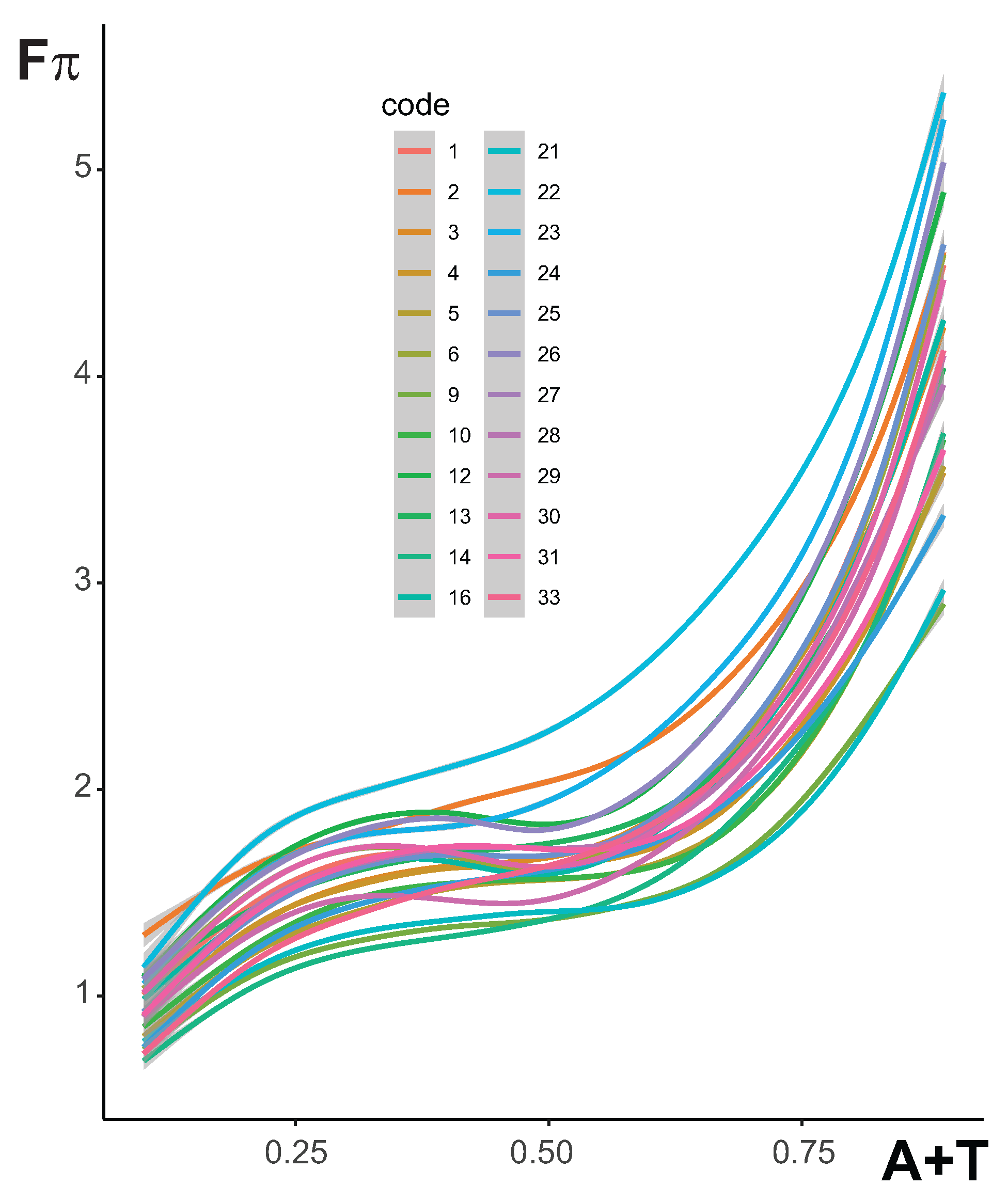
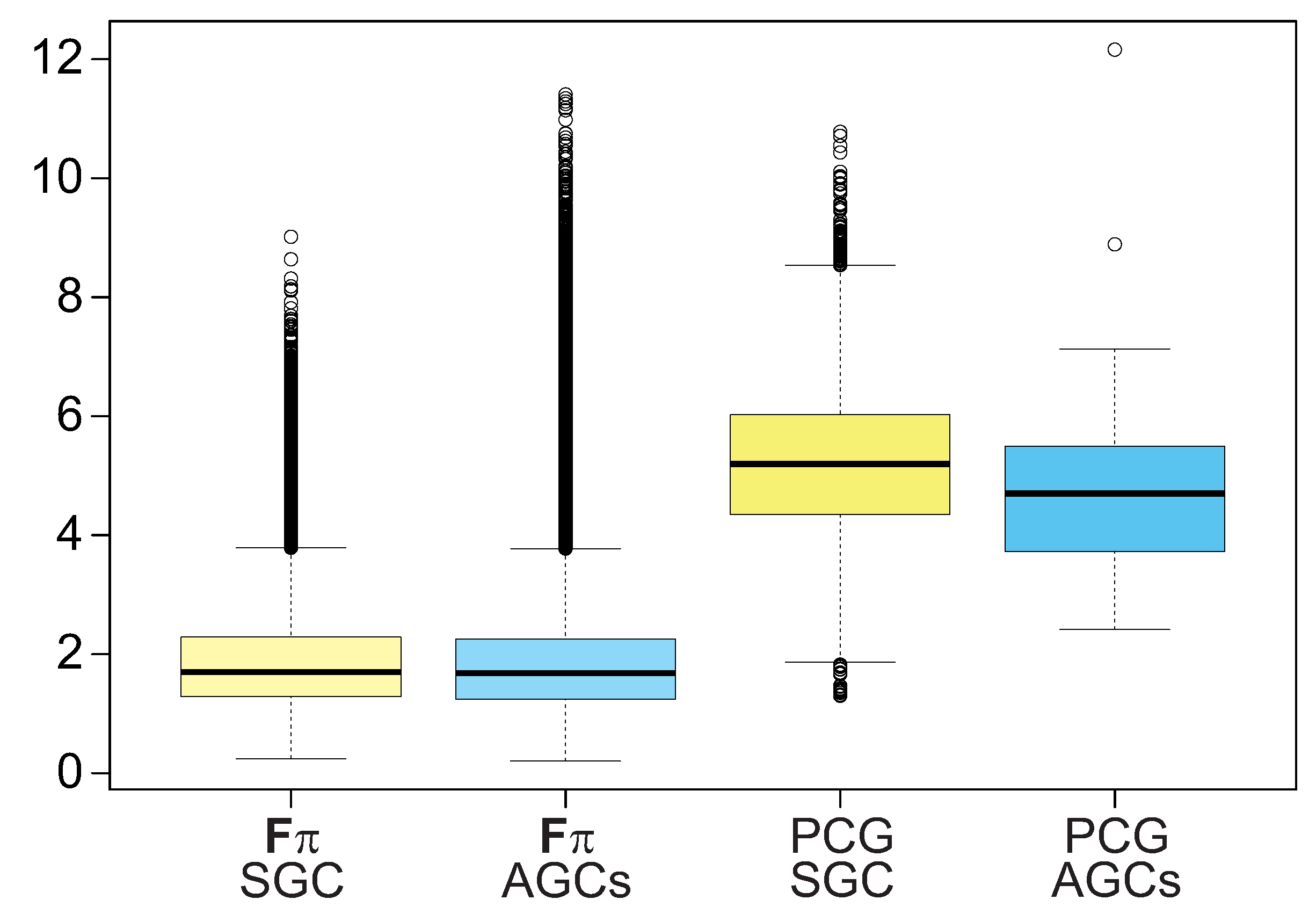
| Code | % | % | % | |||
|---|---|---|---|---|---|---|
| 1 (SGC) | 0.245 | 1.696 | 9.016 | 0.0 | 0.0 | 0.0 |
| 2 | 0.43 | 1.968 | 10.45 | 75.4 | 16.0 | 15.9 |
| 3 | 0.266 | 1.712 | 7.983 | 8.7 | 0.9 | −11.5 |
| 4 | 0.24 | 1.627 | 7.855 | −2.0 | −4.1 | −12.9 |
| 5 | 0.232 | 1.565 | 7.264 | −5.4 | −7.7 | −19.4 |
| 6 | 0.271 | 1.734 | 8.926 | 10.5 | 2.2 | −1.0 |
| 9 | 0.222 | 1.337 | 6.208 | −9.3 | −21.2 | −31.1 |
| 10 | 0.249 | 1.537 | 8.341 | 1.6 | −9.4 | −7.5 |
| 12 | 0.317 | 1.91 | 9.556 | 29.3 | 12.6 | 6.0 |
| 13 | 0.33 | 1.759 | 7.671 | 34.7 | 3.7 | −14.9 |
| 14 | 0.227 | 1.341 | 6.176 | −7.4 | −20.9 | −31.5 |
| 16 | 0.297 | 1.674 | 8.344 | 21.2 | −1.3 | −7.5 |
| 21 | 0.203 | 1.371 | 6.758 | −17.0 | −19.2 | −25.0 |
| 22 | 0.376 | 2.322 | 11.34 | 53.5 | 36.9 | 25.8 |
| 23 | 0.274 | 1.985 | 11.41 | 12.0 | 17.0 | 26.5 |
| 24 | 0.233 | 1.588 | 7.728 | −5.0 | −6.4 | −14.3 |
| 25 | 0.243 | 1.726 | 9.002 | −0.8 | 1.7 | −0.2 |
| 26 | 0.406 | 1.894 | 9.737 | 65.7 | 11.7 | 8.0 |
| 27 | 0.262 | 1.73 | 9.052 | 7.0 | 2.0 | 0.4 |
| 28 | 0.262 | 1.73 | 9.052 | 7.0 | 2.0 | 0.4 |
| 29 | 0.262 | 1.537 | 8.242 | 7.0 | −9.4 | −8.6 |
| 30 | 0.238 | 1.708 | 8.831 | −2.9 | 0.7 | −2.1 |
| 31 | 0.256 | 1.708 | 7.742 | 4.6 | 0.7 | −14.1 |
| 33 | 0.248 | 1.608 | 7.42 | 1.3 | −5.2 | −17.7 |
| Code | A | T | C | G | |
|---|---|---|---|---|---|
| 1 (SGC) | 0.05 | 0.07 | 0.2 | 0.68 | 0.245 |
| 2 | 0.05 | 0.12 | 0.66 | 0.17 | 0.430 |
| 3 | 0.05 | 0.05 | 0.21 | 0.69 | 0.266 |
| 4 | 0.05 | 0.06 | 0.17 | 0.72 | 0.240 |
| 5 | 0.05 | 0.06 | 0.7 | 0.19 | 0.232 |
| 6 | 0.05 | 0.06 | 0.17 | 0.72 | 0.271 |
| 9 | 0.05 | 0.07 | 0.31 | 0.57 | 0.222 |
| 10 | 0.05 | 0.09 | 0.29 | 0.57 | 0.249 |
| 12 | 0.05 | 0.07 | 0.71 | 0.17 | 0.317 |
| 13 | 0.05 | 0.07 | 0.71 | 0.17 | 0.330 |
| 14 | 0.05 | 0.05 | 0.21 | 0.69 | 0.227 |
| 16 | 0.06 | 0.05 | 0.23 | 0.66 | 0.297 |
| 21 | 0.05 | 0.06 | 0.68 | 0.21 | 0.203 |
| 22 | 0.06 | 0.07 | 0.41 | 0.46 | 0.376 |
| 23 | 0.05 | 0.08 | 0.29 | 0.58 | 0.274 |
| 24 | 0.06 | 0.09 | 0.41 | 0.44 | 0.233 |
| 25 | 0.05 | 0.06 | 0.2 | 0.69 | 0.243 |
| 26 | 0.07 | 0.13 | 0.32 | 0.48 | 0.406 |
| 27 | 0.05 | 0.09 | 0.21 | 0.65 | 0.262 |
| 28 | 0.05 | 0.09 | 0.21 | 0.65 | 0.262 |
| 29 | 0.05 | 0.13 | 0.26 | 0.56 | 0.262 |
| 30 | 0.05 | 0.05 | 0.15 | 0.75 | 0.238 |
| 31 | 0.05 | 0.05 | 0.83 | 0.07 | 0.256 |
| 33 | 0.05 | 0.05 | 0.16 | 0.74 | 0.248 |
| Code | A | T | C | G | |
|---|---|---|---|---|---|
| 1 (SGC) | 0.84 | 0.05 | 0.05 | 0.06 | 9.01596 |
| 2 | 0.81 | 0.07 | 0.06 | 0.06 | 10.445 |
| 3 | 0.15 | 0.73 | 0.06 | 0.06 | 7.98304 |
| 4 | 0.22 | 0.67 | 0.05 | 0.06 | 7.85467 |
| 5 | 0.17 | 0.71 | 0.05 | 0.07 | 7.26361 |
| 6 | 0.11 | 0.77 | 0.05 | 0.07 | 8.92571 |
| 9 | 0.11 | 0.77 | 0.05 | 0.07 | 6.2084 |
| 10 | 0.09 | 0.8 | 0.05 | 0.06 | 8.34086 |
| 12 | 0.07 | 0.81 | 0.06 | 0.06 | 9.55644 |
| 13 | 0.07 | 0.82 | 0.05 | 0.06 | 7.67111 |
| 14 | 0.22 | 0.67 | 0.05 | 0.06 | 6.17645 |
| 16 | 0.82 | 0.07 | 0.05 | 0.06 | 8.34363 |
| 21 | 0.12 | 0.77 | 0.05 | 0.06 | 6.75813 |
| 22 | 0.84 | 0.05 | 0.05 | 0.06 | 11.3414 |
| 23 | 0.84 | 0.05 | 0.05 | 0.06 | 11.4083 |
| 24 | 0.09 | 0.8 | 0.05 | 0.06 | 7.72787 |
| 25 | 0.78 | 0.11 | 0.05 | 0.06 | 9.0016 |
| 26 | 0.09 | 0.8 | 0.05 | 0.06 | 9.73709 |
| 27 | 0.21 | 0.68 | 0.05 | 0.06 | 9.05196 |
| 28 | 0.21 | 0.68 | 0.05 | 0.06 | 9.05196 |
| 29 | 0.19 | 0.69 | 0.06 | 0.06 | 8.24171 |
| 30 | 0.84 | 0.05 | 0.05 | 0.06 | 8.83112 |
| 31 | 0.1 | 0.79 | 0.05 | 0.06 | 7.74191 |
| 33 | 0.14 | 0.75 | 0.05 | 0.06 | 7.41951 |
| Number | Code Description |
|---|---|
| 1 | Standard |
| 2 | Vertebrate Mitochondrial |
| 3 | Yeast Mitochondrial |
| 4 | Mold, Protozoan and Coelenterate Mitochondrial and Mycoplasma/Spiroplasma |
| 5 | Invertebrate Mitochondrial |
| 6 | Ciliate, Dasycladacean and Hexamita Nuclear |
| 9 | Echinoderm and Flatworm Mitochondrial |
| 10 | Euplotid Nuclear |
| 12 | Alternative Yeast Nuclear |
| 13 | Ascidian Mitochondrial |
| 14 | Alternative Flatworm Mitochondrial |
| 16 | Chlorophycean Mitochondrial |
| 21 | Trematode Mitochondrial |
| 22 | Scenedesmus obliquus Mitochondrial |
| 23 | Thraustochytrium Mitochondrial |
| 24 | Rhabdopleuridae Mitochondrial |
| 25 | Candidate Division SR1 and Gracilibacteria |
| 26 | Pachysolen tannophilus Nuclear |
| 27 | Karyorelict Nuclear |
| 28 | Condylostoma Nuclear |
| 29 | Mesodinium Nuclear |
| 30 | Peritrich Nuclear |
| 31 | Blastocrithidia Nuclear |
| 33 | Cephalodiscidae Mitochondrial UAA-Tyr |
Disclaimer/Publisher’s Note: The statements, opinions and data contained in all publications are solely those of the individual author(s) and contributor(s) and not of MDPI and/or the editor(s). MDPI and/or the editor(s) disclaim responsibility for any injury to people or property resulting from any ideas, methods, instructions or products referred to in the content. |
© 2023 by the authors. Licensee MDPI, Basel, Switzerland. This article is an open access article distributed under the terms and conditions of the Creative Commons Attribution (CC BY) license (https://creativecommons.org/licenses/by/4.0/).
Share and Cite
Pawlak, K.; Błażej, P.; Mackiewicz, D.; Mackiewicz, P. The Influence of the Selection at the Amino Acid Level on Synonymous Codon Usage from the Viewpoint of Alternative Genetic Codes. Int. J. Mol. Sci. 2023, 24, 1185. https://doi.org/10.3390/ijms24021185
Pawlak K, Błażej P, Mackiewicz D, Mackiewicz P. The Influence of the Selection at the Amino Acid Level on Synonymous Codon Usage from the Viewpoint of Alternative Genetic Codes. International Journal of Molecular Sciences. 2023; 24(2):1185. https://doi.org/10.3390/ijms24021185
Chicago/Turabian StylePawlak, Konrad, Paweł Błażej, Dorota Mackiewicz, and Paweł Mackiewicz. 2023. "The Influence of the Selection at the Amino Acid Level on Synonymous Codon Usage from the Viewpoint of Alternative Genetic Codes" International Journal of Molecular Sciences 24, no. 2: 1185. https://doi.org/10.3390/ijms24021185
APA StylePawlak, K., Błażej, P., Mackiewicz, D., & Mackiewicz, P. (2023). The Influence of the Selection at the Amino Acid Level on Synonymous Codon Usage from the Viewpoint of Alternative Genetic Codes. International Journal of Molecular Sciences, 24(2), 1185. https://doi.org/10.3390/ijms24021185







